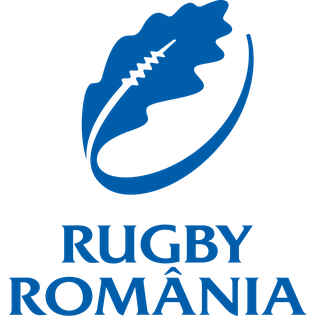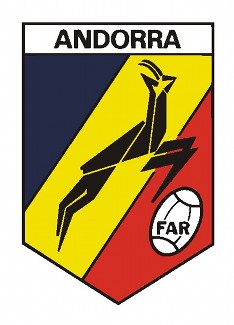
The Italy national rugby union team represents the Italian Rugby Federation in men's international rugby union. The team is known as gli Azzurri. Savoy blue is the common colour of the national teams representing Italy, as it is the traditional colour of the royal House of Savoy which reigned over the Kingdom of Italy from 1860 to 1946.

The Romania national rugby union team represents Romania in men's international rugby union competitions. Nicknamed Stejarii, the team is long considered one of the stronger European teams outside the Six Nations. They have participated in all but one Rugby World Cup and currently compete in the first division of the European Nations Cup, which they won in 2017. Rugby union in Romania is administered by the Romanian Rugby Federation.
The Rugby Europe International Championships is the European Championship for tier 2 and tier 3 rugby union nations.

The Andorra national rugby union team, nicknamed Els Isards represent the Andorran Rugby Federation (FAR) in international rugby union competitions. They play most of their home games in Andorra la Vella, the country's capital, though have had some matches in Foix, which is in France.

The Russia national rugby union team, nicknamed Medvedi, represented Russia in men's international rugby union international competitions. The team is administered by the Rugby Union of Russia (RUR). The RUR is considered the official successor union of the Soviet Union by World Rugby and the combined CIS team which played in the early 1990s. Since 1992, the team has played as Russia. Its first test match as Russia was against the Barbarians in Moscow in June 1992 and the country's first test against an official Test nation was against Belgium later that same year.

The Germany national rugby union team represents Germany in men's international competitions. It currently plays at the second level of European rugby but is yet to qualify for the Rugby World Cup. The national team first played in 1927, with rugby union in Germany being administered by the German Rugby Federation.

The Morocco national rugby union team are a national sporting side, representing Morocco in rugby union. The team is also known as the Atlas Lions. Morocco is governed by the Fédération Royale Marocaine de Rugby. Morocco competes in the Africa Cup annually. The team has won the competition in 2003 and 2005. They usually play their internationals in Casablanca.
The Ireland women's national rugby union team represents Ireland in international women's rugby union competitions such as the Women's Six Nations Championship and the Women's Rugby World Cup. They have also represented Ireland in the FIRA Women's European Championship. Ireland won the 2013 and 2015 Women's Six Nations Championships. In 2013 they also achieved both a Triple Crown and Grand Slam. They finished fourth in the 2014 Women's Rugby World Cup after defeating New Zealand in the pool stages. Ireland hosted the 2017 Women's Rugby World Cup. The team was originally organised by the Irish Women's Rugby Football Union. However, since 2009 it has been organised by the Irish Rugby Football Union
The 2008–10 European Nations Cup First Division was the 7th edition of the championship since it was reformed in 2000. The championship not only determined the champions of the ENC but it also acted as an element of European qualification for the 2011 Rugby World Cup in New Zealand.
The Rugby Europe Under-18 Championship is an annual rugby union championship for Under-18 national teams, held since 2004. The championship is organised by rugby's European governing body, Rugby Europe.
The 2011 European Under-18 Rugby Union Championship was the eighth annual international rugby union competition for Under 18 national rugby union teams in Europe. The event was organised by rugby's European governing body, the FIRA – Association of European Rugby (FIRA-AER). The competition was contested by 28 men's junior national teams and will be held in April 2011. It was hosted by the French region of Armagnac and Bigorre. The tournament was won by the under-18 team of Ireland, who took out the title for the first time, beating England in the final. For the first time, France did not reach the championship game and finished in fourth place only.
The 1983–84 FIRA Trophy was the 24th edition of a European rugby union championship for national teams.
The 1989–90 FIRA Trophy was the 28th edition of a European rugby union championship for national teams. The format returned to a one-year tournament, with each team facing each other only once.
The 1990–92 FIRA Trophy was the 29th edition of a European rugby union championship for national teams. The format returned to a two-year tournament.
The 1995–1997 FIRA Trophy was the 31st edition of the European rugby union championship for national teams. The 1995-97 edition was arranged once again with a new format.
The 1996–97 FIRA Tournament was the 32nd edition of the European rugby union championship for national teams organized by the Fédération Internationale de Rugby Amateur (FIRA).
The 2012–14 European Nations Cup First Division is the premier rugby union competition below the Six Nations Championship in Europe. It is divided into two tiers; Division 1A and Division 1B.
The 2012–14 European Nations Cup Second Division is the third tier rugby union in Europe behind the Six Nations Championship and the 2012-2014 European Nations Cup First Division.
The 2014–16 European Nations Cup First Division is the premier rugby union competition below the Six Nations Championship in Europe. It is divided into two tiers; Division 1A and Division 1B.

Rugby Europe is the administrative body for rugby union in Europe. It was formed in 1999 to promote, develop, organise, and administer the game of rugby in Europe under the authority of World Rugby. However, it is not responsible for the organisation of the Six Nations Championship or the competitions run by European Professional Club Rugby.






